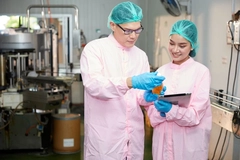Mixed bag: Research finds dietary app has “modest” health outcome terms but hails nutritional education

17 Mar 2023 --- Studies suggest that using the UK Change4Life Food Scanner app reduces healthcare resource costs, school absences and workplace productivity losses and a modest cost per quality of adjusted life years for parents using it. However, additional research is needed with a larger sample, longer follow-up period and economic modeling.
NutritionInsight sits down with lead author Sundus Mahdi, a Ph.D. researcher at the University of Sheffield, UK, who has evaluated different aspects of the Food Scanner app in multiple studies.
“Current research suggests that dietary apps have modest effects. But, given their wide reach, these effects can be substantial at a population level.”
“When exploring the economic and health impacts of the Food Scanner app, we found that the app is unlikely to result in any changes to health-related quality of life outcomes in children.”
“However, we did have a short follow-up period of three months within the trial, so it is unlikely that this time is sufficient to witness changes in health outcomes, especially within a healthy population.”
The authors of the study, published in Frontiers in Nutrition, could not account for costs relating to the development, maintenance and promotion of the app.
The potential of food scanner apps
Mahdi notes that changing dietary behaviors requires effort from numerous policies that work together. Along with the Food Scanner app’s economic and health impacts, she has investigated its behavior change techniques and effect on reducing children’s sugar intake.
 The Change4Life Food Scanner app aims to provide families with feedback on the nutritional content of packaged foods.“Although some dietary apps may not lead to substantial health improvements, they can be used to raise awareness of the nutritional content within our food, which is a good starting point.”
The Change4Life Food Scanner app aims to provide families with feedback on the nutritional content of packaged foods.“Although some dietary apps may not lead to substantial health improvements, they can be used to raise awareness of the nutritional content within our food, which is a good starting point.”
She adds that although the Food Scanner app consists of evidence-based behavior change techniques (components that change behavior), the studies’ “data does not suggest that those using the Food Scanner app have reduced sugar and energy intake compared to those not using the app.”
It is not easy to keep users of dietary apps engaged over time, finds Mahdi.
“App creators ought to engage their target audience in discussions around app features and content to ensure that dietary apps meet the end user’s needs, which will likely increase engagement and effectiveness.”
Change4Life Food Scanner
The UK government developed the app to provide families with feedback on the nutritional content of packaged foods.
Mahdi explains that the app communicates nutritional information in an interesting and easy-to-understand format, such as using sugar cubes to demonstrate sugar content.
“The Change4Life Food Scanner app is very popular and has had a lot of costs and resources spent toward its development and continued maintenance.”
“I hoped that my research could provide insight into whether the app was effective in changing behavior and cost-effective. This could help advise on whether costs and resources may be better invested in other health promotion strategies.”
In the US, only half of parents regularly give their children multivitamins as nutritious food is deemed expensive.
Study set-up
Through stakeholder engagement, the researchers developed a conceptual model to map how the app leads to short- and long-term outcomes. With the model, the researchers developed a pilot randomized controlled trial into the feasibility and acceptability of evaluating clinical outcomes in children, as well as the economic effects of the app.
In the study, 126 parents of four to 11-year-olds were divided into two groups, one using the app and one control group. Around half of the participants completed the study.
 Changing dietary behaviors requires numerous policies that work together, notes Mahdi.The parents filled out a tool on their children’s health outcomes. The researchers collected child healthcare resource use and costs, school absenteeism and parent productivity losses at baseline and three months follow-up.
Changing dietary behaviors requires numerous policies that work together, notes Mahdi.The parents filled out a tool on their children’s health outcomes. The researchers collected child healthcare resource use and costs, school absenteeism and parent productivity losses at baseline and three months follow-up.
The authors highlight that app promotion is necessary to maximize app uptake and can potentially increase the cost-effectiveness of app-based interventions.
Next steps
The authors note that this is the first study to assess the costs and associated consequences of a UK government dietary app but warn that results should be interpreted cautiously as all analyses are preliminary.
Mahdi explains, “Usually, these studies have small sample sizes and should not do significance testing unless for exploratory purposes rather than to reach conclusions.”
“As a next step, a large trial would determine whether the app effectively reduces sugar and energy intake levels in children. Economic modeling studies could also help estimate an intervention’s long-term health and cost outcomes.”
Madhi concludes that further research should look into the effectiveness of dietary smartphone apps, uptake, duration of use and the variability of costs associated with the development and ongoing maintenance of dietary apps.
By Jolanda van Hal












